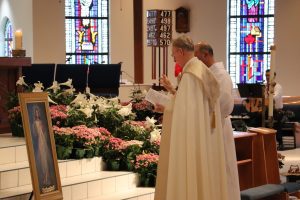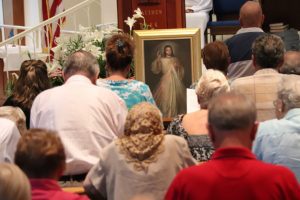Bob Reddy – Florida Catholic
4/10/18
The Second Sunday of Easter, or Divine Mercy Sunday, completes the Octave of Easter, a celebration of the resurrection of Jesus Christ and the blessing of His continuing presence in our midst. The Gospel reading for Divine Mercy Sunday recalls the encounter between St. Thomas and Jesus after the Resurrection.
 For many in the Diocese of Venice, the Feast of Divine Mercy takes on a powerful meaning when they participate in a private or public prayer called the Chaplet of Divine Mercy. Each year dozens of parishes throughout the Diocese hold Divine Mercy services and novenas. The popularity of Divine Mercy has been noticed and embraced by the many diverse communities throughout the Diocese.
For many in the Diocese of Venice, the Feast of Divine Mercy takes on a powerful meaning when they participate in a private or public prayer called the Chaplet of Divine Mercy. Each year dozens of parishes throughout the Diocese hold Divine Mercy services and novenas. The popularity of Divine Mercy has been noticed and embraced by the many diverse communities throughout the Diocese.
Divine Mercy Sunday became a tradition in a few short years as parishes throughout the Diocese and the world celebrate the mercy of Jesus recalled to us by St. Maria Faustina Kowalska, a religious sister who lived a humble life to whom Jesus appeared. St. Faustina was born in Krakow, Poland and lived from 1905-1938 being canonized by St. Pope John Paul II in 2000 who at that time declared the Second Sunday of Easter is Divine Mercy Sunday.
 The image of the Divine Mercy was created by St. Faustina who was told to paint the image of Jesus as she saw Him. The painting has the saying at the bottom: “Jesus, I trust in You.” The rays emanating from Jesus represent water – which makes souls righteous — and blood — which is the life of souls, Jesus told St. Faustina.
The image of the Divine Mercy was created by St. Faustina who was told to paint the image of Jesus as she saw Him. The painting has the saying at the bottom: “Jesus, I trust in You.” The rays emanating from Jesus represent water – which makes souls righteous — and blood — which is the life of souls, Jesus told St. Faustina.
Among the practices associated with the devotion are its novena, the Chaplet of the Divine Mercy (a series of prayers organized similarly to a rosary), the Hour of Great Mercy (a time of prayer traditionally celebrated at 3 p.m.), and the plenary indulgence granted to those who receive the Eucharist and celebrate reconciliation on Divine Mercy Sunday.
 At Our Lady of Lourdes Parish in Venice, the celebration of Divine Mercy Sunday included a traditional afternoon prayer service. This included a blessing of the image of Mercy, prayer of consecration to the image of Mercy, the singing of Chaplet of Divine Mercy, veneration of the image of Mercy, Exposition of the Blessed Sacrament, Adoration, Benediction, the Divine Praises and a closing hymn. An image of the St. Faustina painting was on display during the prayer service.
At Our Lady of Lourdes Parish in Venice, the celebration of Divine Mercy Sunday included a traditional afternoon prayer service. This included a blessing of the image of Mercy, prayer of consecration to the image of Mercy, the singing of Chaplet of Divine Mercy, veneration of the image of Mercy, Exposition of the Blessed Sacrament, Adoration, Benediction, the Divine Praises and a closing hymn. An image of the St. Faustina painting was on display during the prayer service.
For Joan Conway, participating in the Divine Mercy Sunday celebration has become something she looks forward to each year as the Divine Mercy image is one that speaks to her deeply. As such, she participates in the Novena of Divine Mercy beginning on Good Friday and looks forward to the prayer service on the Second Sunday of Easter.
“It is truly a great way to transition from Lent into the Easter Season,” Conway said. “The bridge carries me through the Passion of the Lord, the Resurrection and now His appearing before the Disciples and being merciful to St. Thomas. So wonderful to participate in that is such a special way.”
The Solemnity of Divine Mercy Sunday is a time to remind the faithful that the Lord’s Mercy has no end.
In St. Peter’s Square, Pope Francis reminded the faithful that “every time we are forgiven, we are reassured and encouraged, because each time we experience more love, and more embraced by the Father. And when we fall again, precisely because we are loved, we experience even greater sorrow – a beneficial sorrow that slowly detaches us from sin.”
The celebration of Divine Mercy Sunday is an opportunity to reflect on the theme of how God’s Mercy can overcome sin and, as the Congregation for Divine Worship and the Discipline of the Sacraments states, “a perennial invitation to the Christian world to face, with confidence in divine benevolence, the difficulties and trials that mankind [sic] will experience in the years to come.”





